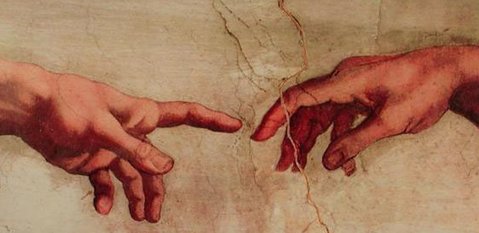Kepler-science.nl
The English pages can be found in the second row of the menu
De eerste rij knoppen in het menu is voor de Nederlandse pagina's
The complex cell
The cell is the basic unit of life: all living organisms consist of cells. More and more we discover how wonderfully complex these cells are and operate.
Even into the 20th century we had a simple idea of the cell. It doesn't look much more than a simple little box with some 'grains' in int under the light microscope - surrounded or not with a cell wall. The electron-miscroscope (EM) drastically changed this picture.
Higly organised
Watching the video 'Inner life of the Cell' you will be impressed: the cell is packed with organelles and structures, is highly organised. This idea is based on years of research with different types of the electron microscope and into the biochemistry of the cell. More and more we discover an amazing complexity: molecules and structures are constantly being made and broken down or replaced and a lot of directed transport takes place - by motor proteins (see link 1) and through the channels of the membrane network in the cell (called endoplasmatic reticulum).
This view of the cell is totally different from what Darwin and his contemparies had. In that time it seemed understandable and feasible that living cells would emerge 'just by themselves' - though Pasteur in 1860 disproved spontaneous generation. For more see Origin>Life.
Under the light microscope
You don't see very much of the structure of the cell using the light microscope. Just take a look at the pictures of slides of cheek cells and Elodea leaf cells in the slide show above (these two slides can be prepared very easily by firstyear students of secondary school). In principal we don't see much more through the light microscope than the following parts of the cell (calles organelles):
- The nucleus with a few dark spots can be seen in many slides, but sometimes the contrast is too low to discern it. The dark spots are active spots of our DNA - here RNA for the ribosomes is constantly being produced. Ribosomes are the protein factories of the cell.
- Mitochondria can often be see, but are hard to recognize: you don't see much more than tiny specks. They are very important, being the energy plats of the cell with ATP as the main output. ATP is a molecule that facilitates reactions in the cell that require energy. The production of ATP is a miracle in itself: watch the short video about ATP synthase. On top of that: the whole process of releasing energy from the breakdown of sugar (and the like) is a remarkable and complicated chain of reactions with a lot of enzymes involved.
- Chloroplasts can only be found in plants cells (in many leaf cells and also in the stem - if it's green). You can recognize these very well in microscopic slides and sometimes you see them moving around because the protoplasma in the cel is in motion - but you don't see the cause of that movement. Watch the video!
- The cell wall in plant cells is made of cellulose and has an open (with channels like in a sponge) and elastic structure. This cell wall is aroound and outside the living cell: if the cell dies, the cell wall sometimes remain intact. The cell wall can be reinforces with cork or lignin. The bark of trees is made of empty cork cells and the wood of a tree consists of empty lignified cells (lignin makes cells into 'wood'). These xylem cells ('wood' cells) form long channels for the transport of water and minerals from root to leaves. This is an amazing system: this transport is driven by osmosis in the root and in the leaves, but also driven by active absorption and transport of minerals in the living root cells. The cell walls of bacteria are complexer than in plants and differs between different groups of bacteria - that's an amazing fact!
Complicated 'machines'
So there is a lot more than we can behold using the light microscope. In different places in the cell we find amazing moleculair 'machines' - miniatuure examples of high end technological skill. These are clear examples of design by a very intelligent Designer. The much less sophisticated versions we come across in our every day life (in all the machines and computers we use in our houses, offices and factories) also didn't emerge by chance: we know and can easily they are designed. Their designers try to produce ever more complex and more compact versions - more and more inspired by what we find in living cells and organisms. Our engineers find inspiration in what God as the Great Designer shows in nature.
See the animations of ATP-synthase and topo-isomerase for examples of these amazing moleculair machines.
Also see the links nr. 2, 3 and 5 for other examples of these wonderful machines in our cells.
Watch the video "Inner Life of the Cell" (complete with comments on what you see happeing) and be impressed by the complexity of the cell - and of life. The cell is packed with meaningful structures.
ATP synthase is a complex 'machine', situated in the membrane of mitochondria.
Plasma movement in the cell can be observed by the movement of chloroplasts
The wonderful machine of topo-isomerase, untangling the knots that form in the process of duplication of DNA
Links:
- Read about the powerful motor proteins in our cells (Wikipedia page)
- Watch a video about these work horses in the cell.
- Watch a video about the flagellum of bacteria: another example of moleculair machines.
- Watch a video about the cell membrane
- How proteins are folded in the right shape by chaperones - showing more of the complexity of the cell (Wikipedia page).
- Bacterial proteins use quantum mechanics!










